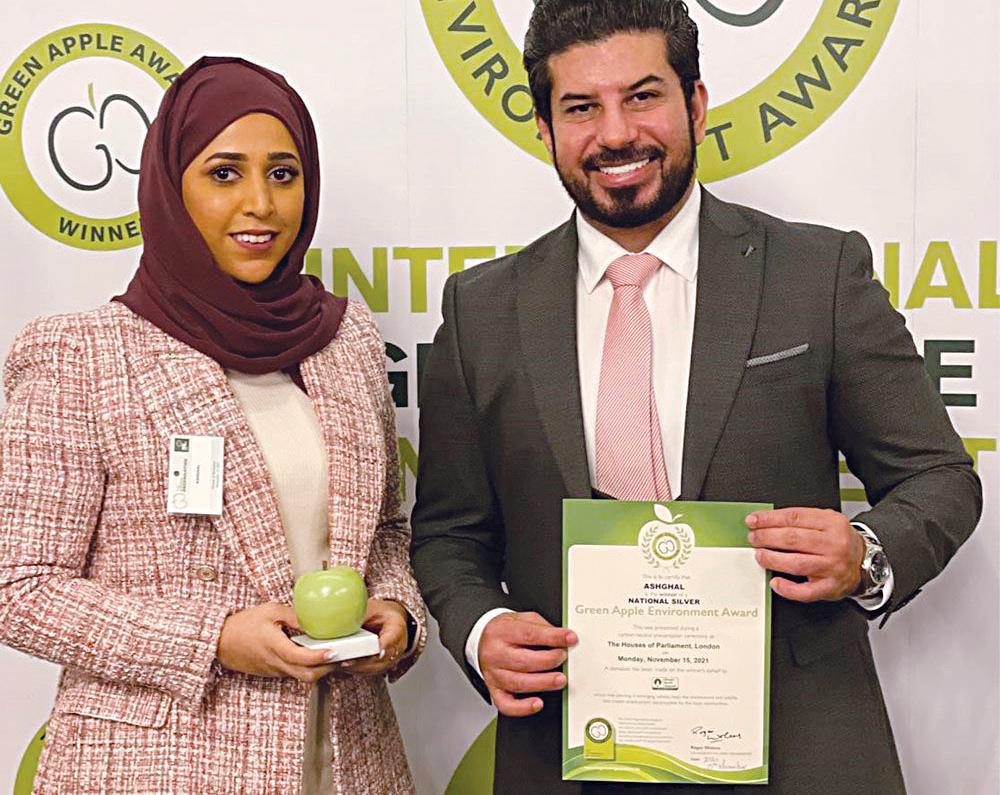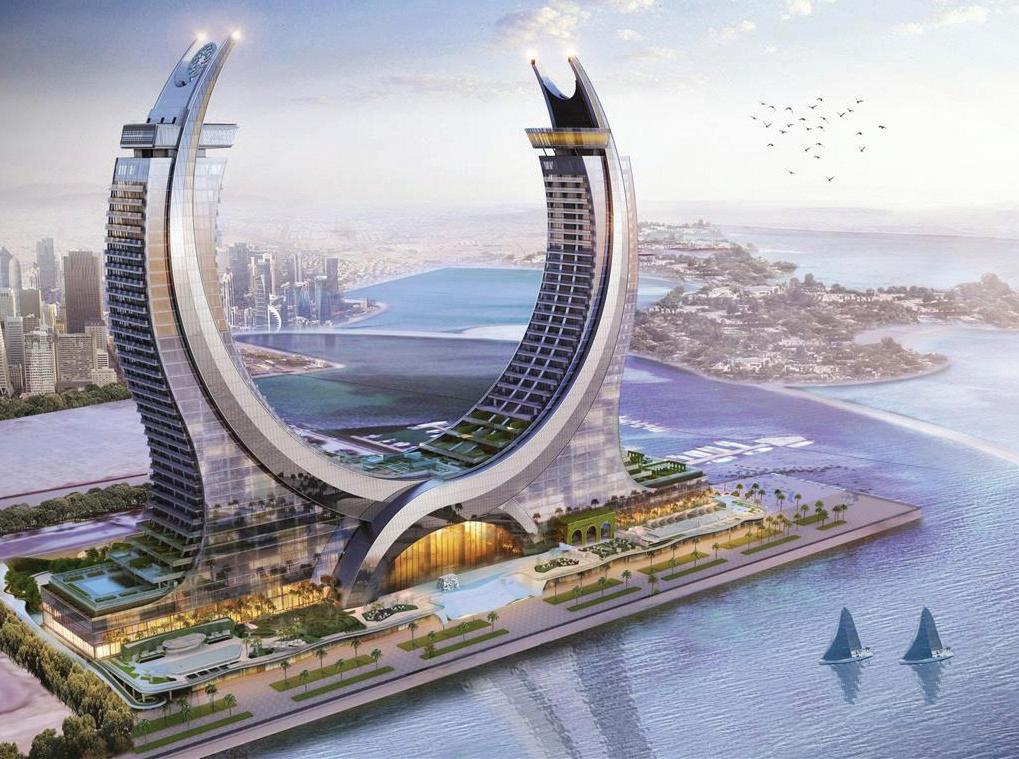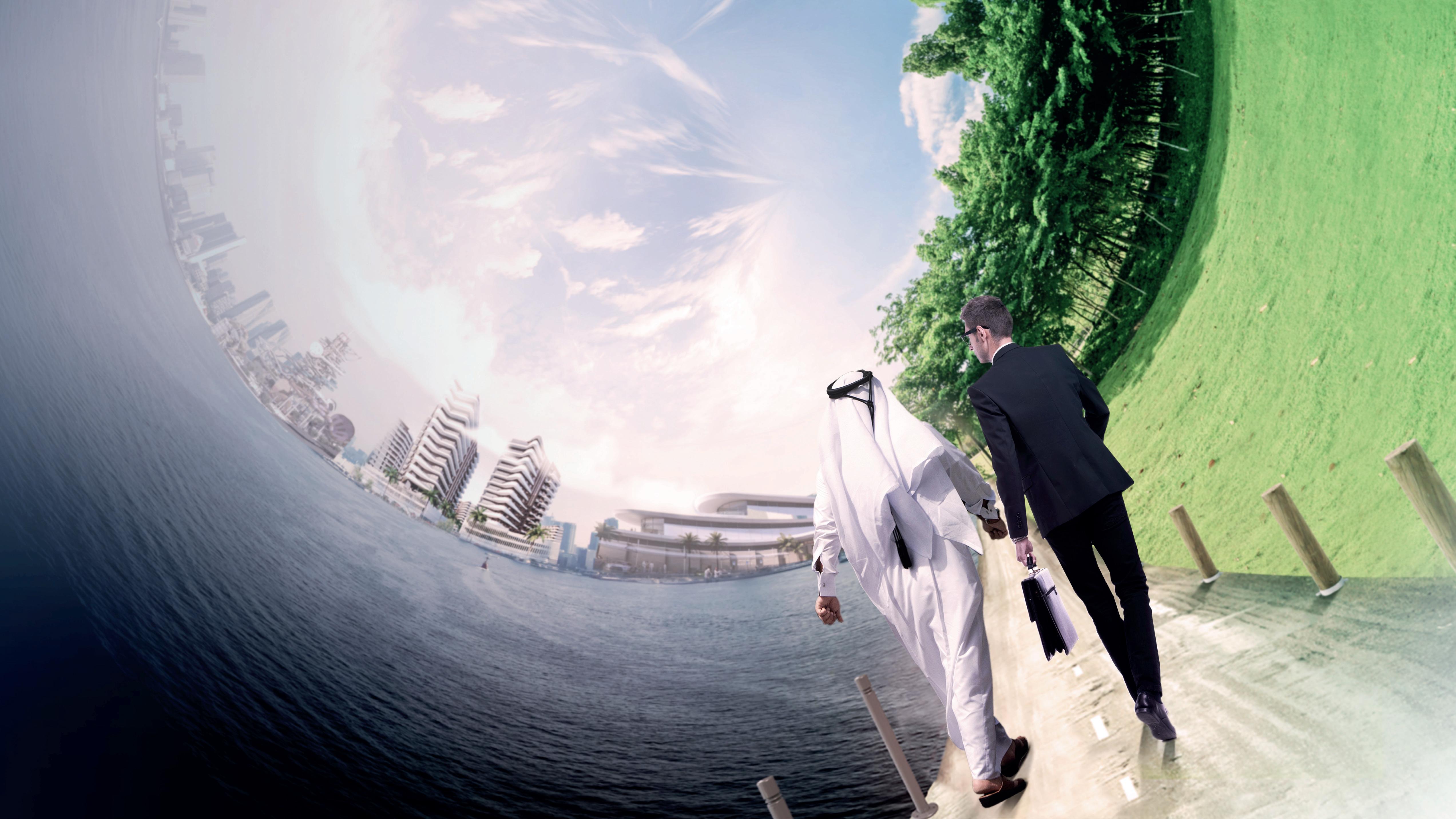
13 minute read
Infrastructure in Qatar
Lusail Towers, designed by Foster + Partners
Qatar National Vision As arguably the world’s fastest-growing economy, Qatar recognises the importance of diversification and sustainability. It also acknowledges the inherent challenges of a rapidly-increasing population, further industrialisation, and the resultant need for an ever-expanding infrastructure. To manage these challenges in effectively, Qatar National Vision (QNV) 2030 was first published in 2008. Based on the guiding principles of the Permanent Constitution, it defines the nation’s medium-to-long-term objectives and creates a framework for sustainable national strategies. QNV 2030 rests on four pillars – Human, Social, Economic and Environmental Development – each with clearly defined individual long-term outcomes yet important inter-relationships. Under QNV 2030, all new projects should provide a high standard of living for future generations, with investments in education, research, healthcare, transport and industry, to enable Qatar to sustain its own development by 2030. Plans include an integrated transport system, a major overhaul of roads and highways, drainage and sewage, and the renovation of downtown Doha. The first wave of specific actions and targets were defined in the Qatar National Development Strategy (NDS) 2011–2016. NDS 2017–2022 was released in December 2017 by HE Sheikh Abdullah bin Nasser bin Khalifa Al Thani, the previous Prime Minister and Minister of Interior, prepared by the Planning and Statistics Authority and other entities.
Economic Strategy Qatar’s economic development aims to create and sustain a competitive and diversified economy capable of meeting the needs of, and securing a high standard of living for, its population now and in the future. The economy has historically been significantly boosted by growth in the oil, gas and petrochemicals industries. However the government is diversifying economic development elsewhere, especially in view of lower oil prices. Spending on infrastructural projects is again a primary focus in the State Budget for 2022, not only for the FIFA World Cup Qatar 2022TM, but also for the education and healthcare sectors – see Economy in this section for details.
Conferences and Exhibitions An influential player in the region’s MICE market, the first major facility opened in 2011. The Qatar National Convention Centre, a member of Qatar Foundation (QF) and located in Education City, is one of the largest, most technologically advanced venues in the Middle East, employing environmental and sustainability best practices including LEED gold certification. Designed by Arata Isozaki, the award-winning venue features a 3D representation of the Sidra tree, symbol of QF. The 200,000 sq m venue includes a 40,000 sq m exhibition space, a conference hall for 3,800 delegates and a 2,300-seat theatre. The 47,700 sq m Doha Exhibition and Convention Center opened its doors in 2015. The building includes a state-of-the-art exhibition hall, modular wall system, high-tech meeting and conference rooms, and underground parking. Located in Al Dafna, the venue has five exhibition halls, which can be used as one hall of 29,000 sq m thanks to a unique wall partition system. The 18-metre high ceiling is the highest in the Middle East, supported by a revolutionary cantilever roof and is pillar-free. Annual business conferences and exhibitions include Project Qatar, QITCOM, and Cityscape Qatar, as well as the Arab Future Cities Summit, the Green Building Expo, the World Stadium Congress, trade summits and conferences.
Spectacular Buildings Dramatic changes to Doha’s skyline have seen glass and concrete towers built with materials imported from all over the world. The population has increased from nearly 1.7 mn people in 2010 to nearly 2.8 mn in February 2022, mainly living in and around Doha. Just 50 years ago the 20,000 population of Doha lived and worked in single or two-storey structures on the narrow streets of what was just a small town on the southern shore of Doha Bay. In the 1970s, as the country changed from fishing and pearl diving to oil production and export, the decision was taken to reshape Doha Bay, extend the waterfront and expand the town area by
reclaiming land. The area now known as Al Dafna (or ‘West Bay’) was dredged from the sea and the first building was the iconic Sheraton hotel, now dwarfed by the other hotels, office towers and apartment blocks nearby. Demand for town centre real estate has grown, with more luxurious living and working environments, forcing the city upwards. The traditional inwardlooking, small-windowed, courtyard dwellings – cooled naturally or via a wind tower and vented walls – reflect the limitations of building materials and technology at the time. Now developments in glass technology and energy-efficient, eco-friendly air conditioning allows Qatar to build green.
Developments to Infrastructure The public-private partnership (PPP) law, approved by the Cabinet in April 2019, will support projects connected to Qatar National Vision 2030 and the FIFA World Cup Qatar 2022TM. The PPPs will be used for a variety of sectors, including healthcare, education, sports, real estate and infrastructure. The State Budget for 2022 is based on an average oil price of USD55 a barrel, with expenditure increasing by 4.9% to QAR204.3 bn – QAR74.0 bn has been allocated for major projects, largely due to a temporary increase in current expenditure related to the hosting of the FIFA World Cup Qatar 2022TM. The State will continue work on development projects related to infrastructure, citizens’ land development and public services. Read more about the 2022 State Budget in Economy, in this section. Public Works Authority ashghal.gov.qa The Public Works Authority (Ashghal) was established in 2004 for the planning, design, procurement, construction, delivery, and asset management of all infrastructure projects and public buildings in Qatar. Key projects include the Expressway Programme, roads and drainage under the Local Areas Infrastructure Programme, and the Inner Doha Re-sewerage Implementation Strategy. Ashghal launched its Corporate Strategy 2018–2022 under the authority's new vision ‘Excellence in delivering and managing efficient sustainable infrastructure’, with 10 objectives to accomplish its mission of ‘continuously enhancing customer satisfaction through leading project and asset management services and solutions’. Ashghal's Supervisory Committee of Beautification of Roads and Public Places develops major roads, pedestrian and cycle paths, and landscaping, to include parks. More than 15,000 trees and shrubs have already been planted under the G Ring Road Development Project, and 30,000 on Al Khor Road.

Ashghal’s Local Areas Infrastructure Programme won the International Green Apple Environment Award 2021. Comprising more than 70 projects under construction across Qatar, as well as those in the design, tender, and award stages, the aim is to use recycled materials and reduce carbon emissions where possible.
Numerous expressway projects have brought great benefits to navigating around the country. On Al Majd Road, Road 2 links Mesaieed Industrial City with Lusail City, while Road 4 links Mall of Qatar with Ras Laffan. Works on the superhighway Dukhan Road and the B Ring Road development project are both nearing completion. Construction has now been completed on the sewage network in the inner Doha areas, which will enhance efficiency and prevent pollution. Sewage infrastructure requirements continue around the country, and includes the Mesaimeer Pumping Station and Outfall – at 10 km in length, this is one of the longest outfall tunnels in the world. In December 2021, Ashghal handed over 50 new parking lots to the Supreme Committee for Delivery and Legacy in time for the 2021 FIFA Arab Cup™ – they will also be used for the FIFA World Cup Qatar 2022TM. The lots have capacity for more than 50,000 cars and 5,600 buses, serving the stadiums, the Metro's Park and Ride system, and Karwa's bus network.
Qatar General Electricity & Water Corporation km.com.qa The corporation, known as Kahramaa, was established in 2000 under the Ministry of Energy and Industry to regulate and maintain the supply of electricity and water to its customers. Kahramaa transferred ownership of its stations to Qatar Electricity and Water Company in 2002. In 2018 the Minister of State for Energy Affairs, HE Saad Sherida Al Kaabi, assumed responsibility for Kahramaa as part of his remit to oversee the regular and sustainable supply of energy, power and water for domestic purposes.
An ambitious strategic plan sees Kahramaa investing QAR38 bn to meet the increasing demands made to the electricity and water supply, with a further QAR6 bn after 2022. This includes five mega water reservoirs to be online by 2026 to provide storage for 2,300 mn gallons a day of water, while the power generation phase will produce 2,520 megawatts of electricity. The plant will add around 30% water and 25% electricity of local demand once fully completed. The Smart Metering Infrastructure Project is a state-of-the-art platform for deploying smart meters in Qatar. Kahramaa aims to install 600,000 advanced digital meters, which will allow customers to monitor their consumption. This is in line with the corporation's National Program for Conservation and Energy Efficiency (Tarsheed).
Selected Megaprojects in Qatar Qatar is undertaking a number of megaprojects to satisfy QNV 2030 and the football event, good news for both local and international businesses. These include projects with Qatar Rail, Qatar Free Zones Authority, the North Field Expansion under QatarEnergy, and the proposed expansion of Hamad International Airport. Here are just a few: FIFA World Cup Qatar 2022TM qatar2022.qa Previously known as the Qatar 2022 Supreme Committee, the Supreme Committee for Delivery and Legacy (SC) has signed stakeholder agreements with Qatar Rail, Ashghal, Kahramaa, Aspire Zone Federation and Qatari Diar, for projects to deliver the infrastructure for the event. The Official Emblem was unveiled in Doha on 2 September 2019 at 20:22 local time, with the synchronised projection of the emblem onto a number of prominent buildings. The new stadiums, designed by the world's leading architects, reflect aspects of Qatari culture, and take into consideration three priorities: access and comfort, sustainability, and post-tournament legacy. Fans are able see more than one match a day, as the longest distance between venues is just 55 km. • Khalifa International Stadium: Originally built in 1976, the stadium reopened in May 2017 following its renovation. • Al Janoub Stadium: Designed by the late Zaha
Hadid and inspired by traditional dhow boats, the 40,000-seater venue will become the home of
Al Wakra Sports Club with 20,000 seats donated to football projects overseas. The stadium opened on 16 May 2019 for the final of the
Amir's Cup. • Al Bayt Stadium: A 60,000 seater-stadium which will be home to Al Khor Sports Club. The design is based on a Bedouin tent, and will have a retractable roof. After the tournament the stadium's modular seating will reduce to 32,000 with the surplus seats donated to global football development projects. The official opening of
AI Bayt Park took place on 11 February 2020,
National Sport Day. • Education City Stadium: The 40,000-seat venue will in legacy mode become a sports, leisure and social hub for students and local sports clubs.
Half the seats will be donated to stadiums around the world. The stadium was officially completed on 15 June 2020. • Ahmad bin Ali Stadium: An undulating façade and sand dune-shaped structures uses environmentally friendly building materials and practices, with a renewable energy generation system on site. The new home of Al Rayyan Club, nearly half of the 40,000 modular seats will be donated overseas. The stadium opened 18 December 2020 for the Amir Cup final. • Al Thumama Stadium: Designed by Qatari architect Ibrahim M Jaidah, representing the traditional gahfiya, in legacy mode, seating will be reduced from 40,000 to 20,000. The stadium was inaugurated during the 49th Amir Cup Final on 22 October 2021. • Stadium 974 (previously Ras Abu Aboud
Stadium): Built from shipping containers and modular steel, the 40,000-seater stadium is the first fully reusable FIFA stadium. The stadium was inaugurated on 20 November 2021. • Lusail Stadium: Seating 80,000, the stadium in Lusail City will host the opening and closing ceremonies, matches throughout the tournament, and the final, to be held on Qatar National Day, 18 December. Its design is inspired by the fanar lantern and the motifs on bowls and other vessels seen throughout history in the Arab world.
After the tournament, the venue will become a community space with schools, shops, cafés, sporting facilities and clinics. Sustainability is an integral part of the project. The FIFA World Cup Qatar 2022™ Sustainability Progress Report is available online, in a format which enables FIFA, SC and the FIFA World Cup Qatar 2022 LLC (Q22) to continuously update stakeholders on progress and performance regarding tournament sustainability efforts. Qatar Integrated Rail Project corp.qr.com.qa Following its establishment in 2011, Qatar Railways Company (Qatar Rail) is leading one of the largest rail projects in the world to meet the demands of Qatar’s dynamic and growing
population. The company is responsible for the design, construction, commissioning, operation and maintenance of the entire network and systems. The state-of-the-art railway network currently consists of Doha Metro, a rapid transit system connecting communities within Doha and its suburbs, and Lusail Tram, a service for convenient travel within the new city of Lusail. The Doha Metro: Three lines covering the Greater Doha area with connections to commercial and residential areas throughout the city. In central Doha, the Metro network is mainly underground, while at the outskirts it Is at ground level or elevated. The project has been conducted over multiple phases, phase one includes three lines (Red, Gold, and Green) which are now open to the public. • The Red Line is about 40 km running from
Al Wakra in the south to Lusail in the north, with a connection to Hamad International Airport.
There are 18 stations, and passengers can transfer to the Lusail Tram at Legtaifiya and
Lusail stations. • The Green Line runs east from Al Riffa to
Al Mansoura, in the west. • The Gold Line runs from Ras Bu Abboud to
Al Aziziya with 11 stations. Lusail Tram: An integrated transportation system serving Lusail City, a state-of-the art tram based system connecting major points of interest in the city. The tram is designed to travel on streets, sharing road-space with other traffic and pedestrians. The project has four lines and 25 stations, with two interchange stations allowing passengers to access the Doha Metro. Lusail City lusail.com One of the largest projects in Qatar costing an estimated QAR163.8 bn, Lusail City is developed by Lusail Real Estate Development Company (LREDC), a subsidiary of the Qatari Diar Real Estate Investment Company, itself a subsidiary of Qatar Investment Authority. Spanning 38 sq km north of Doha, Lusail City is master planned to accommodate more than 450,000 residents and visitors. Launched in 2004, features include: • Energy City: A centre for government ministries, and public and private company headquarters. • Fox Hills district: Housing for 40,000 residents, with a hospital, schools and mosques. • Place Vendôme: Inspired by Paris' Rue de la Paix.
A mixed-use project with a mall and luxury retail wing, two five-star hotels (Le Royal Meridien and
Palais Vendôme), a luxury collection hotel (Le
Royal Meridien Residences) and entertainment aeas. • Qetaifan Island North: A mixed-use project with a beach club, a linear park and a floating hotel.
Qetaifan Projects is owned by Katara Hospitality. Residents have access to essential services with work continuing on supporting infrastructure. Read more about Lusail City in Discovering Qatar. Msheireb Downtown Doha msheireb.com The flagship project of Msheireb Properties, a subsidiary of Qatar Foundation, Msheireb Downtown Doha (MDD) is the world’s first sustainable downtown regeneration project, the QAR20 bn restoration of a 31 hectare site. Msheireb means ‘a place to drink water’ in Arabic, and is the historical name of downtown Doha. The 'smart city with soul' is aiming for Gold or Platinum LEED Certification. The recently launched Doha Design District, a new design and innovation hub, will grant free zone status to occupants from a multitude of business sectors. MDD is divided into five broad quarters, with hospitality, retail, residential and commercial areas. Barahat Msheireb is the region’s largest covered public square, anchored by the Cultural Forum and the Mandarin Oriental Doha hotel. The Heritage quarter features four historic houses that have been restored and turned into museums. The Diwan Amiri quarter comprises the Diwan Annexe, Amiri Guard building and Qatar National Archive, while Sikkat Wadi Msheireb is fully pedestrianised with the Alwadi Hotel Doha MGallery Hotel Collection and the Park Hyatt Hotel. MDD is the central interchange for the Doha Metro, with other methods of transportation underground for a pedestrian-friendly atmosphere. The MDD tram is available to transport visitors. Read more about MDD in Discovering Qatar. m










